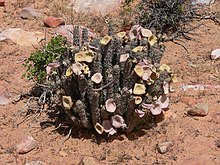Hoodia

| Hoodia | |
|---|---|

| |
| Hoodia gordonii | |
| Scientific classification | |
| Kingdom: | |
| (unranked): | |
| (unranked): | |
| (unranked): | |
| Order: | |
| Family: | |
| Subfamily: | |
| Tribe: | |
| Genus: | Hoodia |
| Species | |
|
See text | |
Hoodia /ˈhʊdiːə/ is a genus of 13 species in the flowering plant family Apocynaceae, under the subfamily Asclepiadoideae.[1] They are stem succulents, described as "cactiform" because of their remarkable similarity to the unrelated cactus family. They can reach up to 1m high and have large flowers, often with tan colour and strong smell.
Hoodia gordonii is traditionally used by the San people (Bushmen) of the Namib desert as an appetite suppressant as part of their indigenous knowledge about survival in the harsh desert conditions. In a well known case of biopiracy, bioprospectors from South Africa’s Council for Scientific and Industrial Research (CSIR) realized that the plant was marketable and patented its use as an appetite suppressant without recognizing the Sans' traditional claims to the knowledge of the plant and its uses.[2] The patent was later sold to Unilever who marketed hoodia products as diet supplements.[3][4][5] In 2003 the South African San Council made an agreement with CSIR in which they would receive from 6 to 8% of the revenue from the sale of Hoodia gordonii products, money which would be deposited in a fund to purchase land for the San people who had been dispossessed from their lands by white settlers.[6]
Many Hoodia species are protected plants, typical of the Namib Desert, ranging from Central Namibia to southern Angola, especially in plains and rocky areas. Common names include "Bushman's Hat" and "Queen of the Namib".
Several species are grown as garden plants, and one species, Hoodia gordonii, is being investigated for use as an appetite suppressant.[7] However, in 2008 UK-based Unilever PLC, one of the largest packaged-food firms in the world, abandoned plans to use hoodia in a range of diet products. In a document on Unilever's website entitled "Sustainable Development 2008: An Overview," signed by Paul Polman, CEO, Unilever states: "During 2008, having invested 20 million [pounds] in R&D, Unilever abandoned plans to use the slimming extract hoodia in a range of diet products. We stopped the project because our clinical studies revealed that products using hoodia would not meet our strict standards of safety and efficacy."
Hoodia is currently listed in Appendix II to the Convention on International Trade in Endangered Species of Wild Fauna and Flora (CITES), which includes species not currently considered endangered but are at risk if trade is not controlled.[8]
Species
- Hoodia alstonii
- Hoodia cactus
- Hoodia currorii (syn. H. lugardii, H. macrantha)
- Hoodia dregei
- Hoodia flava
- Hoodia gordonii (syn. Stapelia gordonii, H. barklyi, H. burkei, H. longispina)
- Hoodia juttae
- Hoodia mossamedensis
- Hoodia officinalis (syn. H. delaetiana)
- Hoodia parviflora
- Hoodia pedicellata
- Hoodia pilifera (syn. H. annulata, H. grandis, H. pillansii)
- Hoodia ruschii (Queen of the Namib)
- Hoodia triebneri (syn. H. foetida)
References
- ^ Stevens PF (2001 onwards) (2007-06-03). "Angiosperm Phylogeny Website: Gentianales". 8. Missouri Botanical Gardens. Retrieved 2008-03-21.
{{cite web}}: CS1 maint: numeric names: authors list (link) - ^ Maharaj, VJ, Senabe, JV, and Horak, RM. 2008. Hoodia, a case study at CSIR. Science real and relevant: 2nd CSIR Biennial Conference, CSIR International Convention Centre Pretoria, 17&18 November 2008, pp 4 [1][2]
- ^ Indigenous Peoples, Consent and Benefit Sharing: Lessons from the San-Hoodia Case (Rachel Wynberg, Doris Schroeder, Roger Chennells Springer, Dec 4, 2009
- ^ Saskia Vermeylen. 2007. Contextualizing ‘Fair’ and ‘Equitable’: The San's Reflections on the Hoodia Benefit-Sharing Agreement Local Environment Vol. 12, Iss. 4,
- ^ Rachel Wynberg 2010 Hot air over Hoodia | 13 October 2010 | Seedling
- ^ Inventing Hoodia: Vulnerabilities and Epistemic Citizenship. 2011. CSW update APRIL [3]
- ^ Wong, Cathy (2007-09-20). ""What You Need to Know About Hoodia Diet Pills" Website: About.com". Retrieved 2008-08-02.
- ^ "CITES Appendices I, II and III". Retrieved 2008-03-21.
